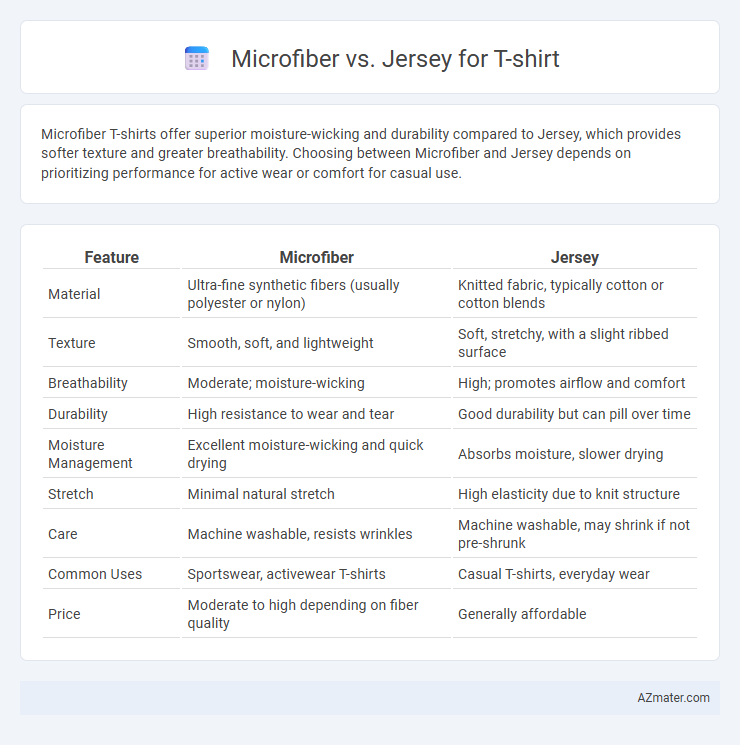Microfiber T-shirts offer superior moisture-wicking and durability compared to Jersey, which provides softer texture and greater breathability. Choosing between Microfiber and Jersey depends on prioritizing performance for active wear or comfort for casual use.
Table of Comparison
| Feature | Microfiber | Jersey |
|---|---|---|
| Material | Ultra-fine synthetic fibers (usually polyester or nylon) | Knitted fabric, typically cotton or cotton blends |
| Texture | Smooth, soft, and lightweight | Soft, stretchy, with a slight ribbed surface |
| Breathability | Moderate; moisture-wicking | High; promotes airflow and comfort |
| Durability | High resistance to wear and tear | Good durability but can pill over time |
| Moisture Management | Excellent moisture-wicking and quick drying | Absorbs moisture, slower drying |
| Stretch | Minimal natural stretch | High elasticity due to knit structure |
| Care | Machine washable, resists wrinkles | Machine washable, may shrink if not pre-shrunk |
| Common Uses | Sportswear, activewear T-shirts | Casual T-shirts, everyday wear |
| Price | Moderate to high depending on fiber quality | Generally affordable |
Introduction to T-shirt Fabrics
Microfiber and jersey fabrics both offer unique properties ideal for T-shirt construction, impacting comfort and performance. Microfiber, made from ultra-fine synthetic fibers, provides moisture-wicking capabilities and durability, making it suitable for activewear. Jersey, typically a knit fabric often crafted from cotton or cotton blends, delivers softness, breathability, and stretch, favored for casual and everyday T-shirts.
What is Microfiber?
Microfiber is a synthetic fiber finer than one denier, typically made from polyester or nylon, known for its exceptional softness, moisture-wicking properties, and durability. Its ultra-fine strands create a lightweight, breathable fabric that dries quickly, making it ideal for performance and activewear T-shirts. Compared to jersey, microfiber offers superior stain resistance and is less prone to shrinking or stretching, enhancing the garment's longevity and comfort.
What is Jersey Fabric?
Jersey fabric is a soft, stretchy knit textile made primarily from cotton or cotton blends, known for its smooth surface and breathable qualities, making it ideal for t-shirts. Unlike microfiber, which is a synthetic fiber known for moisture-wicking and durability, jersey fabric offers natural comfort and flexibility suitable for casual wear. Its unique knit structure provides excellent stretch and shape retention, enhancing fit and comfort in t-shirt designs.
Breathability and Comfort Comparison
Microfiber fabric offers superior moisture-wicking properties, making it highly breathable and ideal for activewear T-shirts. Jersey cotton provides a softer, more natural feel with excellent comfort but may retain more moisture, impacting breathability during intense activity. Choosing between microfiber and jersey depends on prioritizing breathable performance or relaxed comfort in T-shirt wear.
Moisture-Wicking Capabilities
Microfiber fabrics excel in moisture-wicking capabilities due to their fine synthetic fibers that efficiently draw sweat away from the skin, promoting faster evaporation and enhanced breathability. Jersey, commonly made of cotton or cotton blends, offers moderate moisture absorption but dries slower, potentially leading to discomfort during intense physical activities. For high-performance T-shirts aimed at moisture management, microfiber is the preferred choice for maintaining dryness and comfort.
Durability and Longevity
Microfiber T-shirts offer superior durability due to their synthetic fibers that resist wear and tear, maintaining shape and color over extended use. Jersey fabric, typically made from cotton or cotton blends, provides a softer feel but tends to wear out faster with frequent washing and stretching. Choosing microfiber ensures longer-lasting apparel, especially for active or repeated use scenarios.
Style and Appearance Differences
Microfiber T-shirts exhibit a smooth, sleek surface with a subtle sheen that enhances vibrant color retention and provides a modern, polished look. Jersey T-shirts offer a soft, matte texture with visible knit patterns, delivering a classic, casual aesthetic favored for everyday wear. The fine weave of microfiber creates a more tailored fit, while jersey's natural stretch adds comfort and a relaxed silhouette.
Ease of Care and Maintenance
Microfiber T-shirts offer superior ease of care due to their wrinkle resistance and quick-drying properties, allowing for effortless machine washing without special handling. Jersey fabric, often made from cotton or cotton blends, requires more delicate care to prevent shrinking and maintain softness, typically needing gentle washing and air drying. Microfiber's durability and stain resistance contribute to lower maintenance, making it a practical choice for everyday wear compared to jersey.
Best Uses for Microfiber vs Jersey T-Shirts
Microfiber T-shirts excel in moisture-wicking and quick-drying properties, making them ideal for athletic activities, outdoor adventures, and hot weather conditions. Jersey T-shirts offer superior softness, breathability, and stretch, making them perfect for casual wear, everyday comfort, and layering under other garments. Choosing between microfiber and jersey depends on whether performance and moisture management or comfort and style are the primary priorities.
Which Fabric Should You Choose?
Microfiber offers superior moisture-wicking properties and durability, making it ideal for activewear and high-performance T-shirts. Jersey, typically made from cotton or a cotton blend, provides a softer feel and better breathability, perfect for casual, everyday wear. Choose microfiber for athletic activities requiring quick-drying and stretch, while jersey suits comfort-focused, lightweight T-shirts.

Infographic: Microfiber vs Jersey for T-shirt
 azmater.com
azmater.com